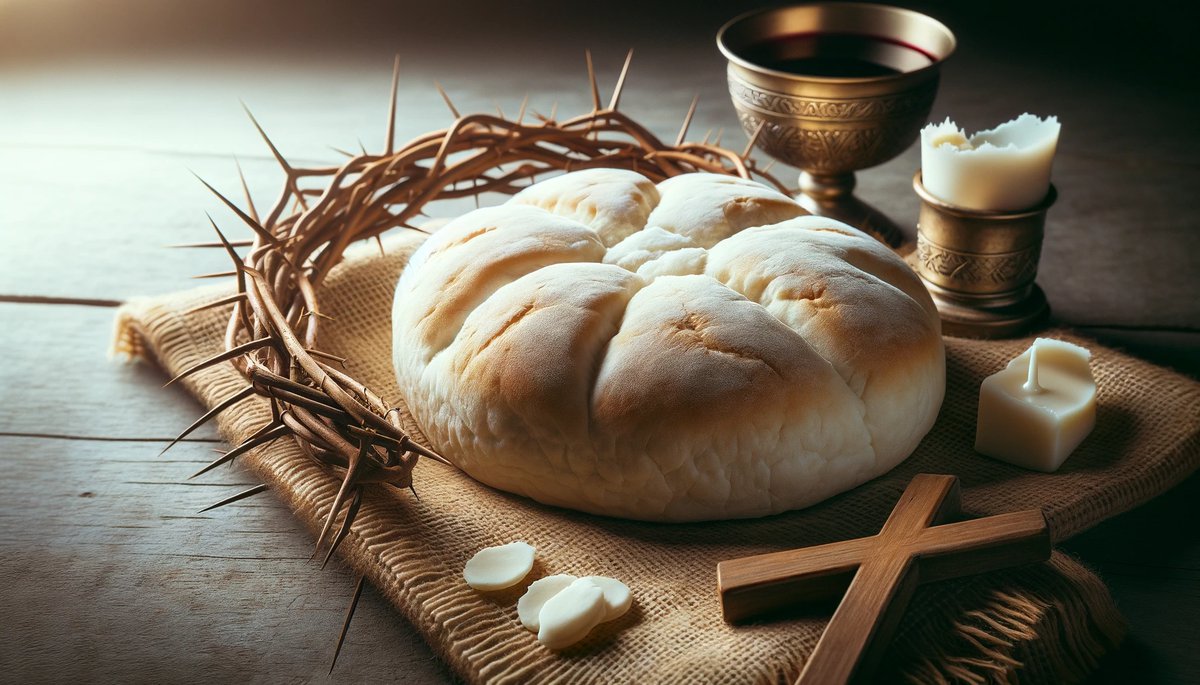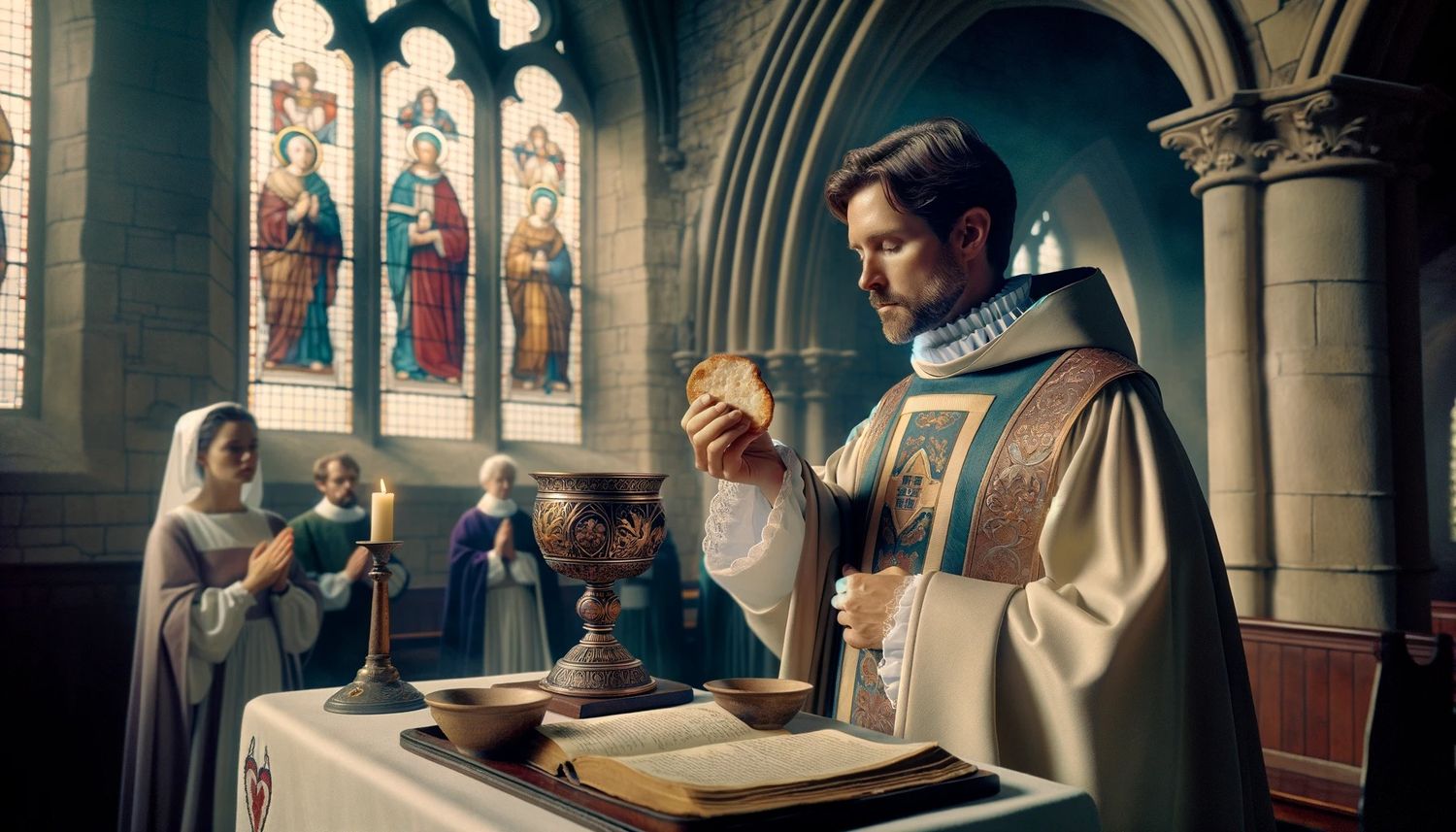Home>Theology and Spirituality>How To Bless The Bread And Wine For Communion


Theology and Spirituality
How To Bless The Bread And Wine For Communion
Published: February 24, 2024
Ericka Andersen, an editor at Christian.net, expertly merges digital strategy with content creation, focusing on faith and societal issues. Her communication skills enhance the platform's engaging narratives, fostering meaningful dialogue on belief's impact on society.
Learn the sacred practice of blessing bread and wine for communion. Discover the theological significance and spiritual importance of this ritual. Explore the rich tradition of communion in theology and spirituality.
(Many of the links in this article redirect to a specific reviewed product. Your purchase of these products through affiliate links helps to generate commission for Christian.net, at no extra cost. Learn more)
Table of Contents
Introduction
Blessing the bread and wine for communion is a sacred and cherished tradition in many Christian denominations. It is a profound act that holds deep spiritual significance, symbolizing the body and blood of Jesus Christ. The ritual of blessing the bread and wine, also known as the Eucharist or Holy Communion, is a central part of Christian worship, representing the Last Supper that Jesus shared with his disciples before his crucifixion.
The act of blessing the bread and wine is rooted in the teachings of Jesus, as recorded in the New Testament. In the Gospel of Matthew, Jesus instructs his disciples during the Last Supper, saying, "Take, eat; this is my body," as he offers them bread, and "Drink from it, all of you; for this is my blood of the covenant," as he presents the wine (Matthew 26:26-28, NRSV). These words form the basis for the sacred ritual of communion, which has been passed down through generations as a way for Christians to remember and partake in the sacrifice of Christ.
The act of blessing the bread and wine is a solemn and reverent practice, signifying the spiritual nourishment and unity of believers. It is a time for reflection, gratitude, and spiritual connection with the divine. The blessing of the bread and wine is not merely a symbolic gesture; it is a profound spiritual act that transcends the physical elements, inviting participants to experience the presence of Christ in a deeply personal and transformative way.
In the following sections, we will delve into the significance of blessing the bread and wine, explore the preparations involved in this sacred ritual, and understand the process of blessing the elements, all of which contribute to the rich tapestry of Christian worship and spiritual life.
Understanding the significance of blessing the bread and wine
Blessing the bread and wine for communion holds profound significance within Christian theology and spirituality. At the heart of this ritual is the belief in the real presence of Christ in the elements of bread and wine, a concept known as "transubstantiation" in Catholic theology and as "real presence" in many Protestant traditions. This belief asserts that, through the act of blessing, the bread and wine become spiritually transformed, representing the body and blood of Jesus Christ.
The act of blessing the bread and wine is deeply rooted in the teachings of Jesus Christ, particularly in the accounts of the Last Supper found in the Gospels. During this final meal with his disciples, Jesus took bread, blessed it, broke it, and gave it to his disciples, saying, "Take, eat; this is my body" (Matthew 26:26, NRSV). He then took a cup of wine, gave thanks, and offered it to them, saying, "Drink from it, all of you; for this is my blood of the covenant" (Matthew 26:27-28, NRSV). These actions and words form the foundation of the Eucharistic ritual, emphasizing the spiritual significance of the bread and wine as symbols of Christ's sacrificial love and the new covenant between God and humanity.
The blessing of the bread and wine also serves as a powerful reminder of the unity of believers within the body of Christ. As participants partake in the Eucharist, they are invited to commune with God and with one another, transcending individual identities and forming a spiritual bond as members of the Christian community. This communal aspect of the ritual underscores the shared faith and fellowship among believers, reinforcing the idea of the Church as the mystical body of Christ.
Furthermore, the act of blessing the bread and wine is a tangible expression of gratitude and remembrance. It is a solemn acknowledgment of Christ's redemptive sacrifice and a celebration of the divine love that permeates the Christian faith. Through the ritual of communion, believers are called to reflect on the profound mystery of Christ's presence in their lives and to express thankfulness for the gift of salvation.
In essence, the significance of blessing the bread and wine for communion extends far beyond a mere symbolic gesture. It embodies the core tenets of Christian faith, encapsulating the themes of spiritual transformation, communal unity, remembrance, and gratitude. As such, the ritual of blessing the bread and wine stands as a central and revered practice within Christian worship, inviting participants to encounter the living presence of Christ and to be nourished by the spiritual sustenance offered through the sacred elements.
Preparing for the blessing
Preparing for the blessing of the bread and wine for communion is a sacred and deliberate process that involves careful attention to both the physical elements and the spiritual disposition of the participants. This preparation is essential for creating a reverent and meaningful experience during the Eucharistic ritual.
Gathering the Elements
The first step in preparing for the blessing involves gathering the necessary elements, namely the bread and wine. The bread, often in the form of unleavened wafers or small loaves, symbolizes the body of Christ, while the wine, typically red wine in many traditions, represents the blood of Christ. These elements are central to the Eucharistic celebration and are handled with utmost reverence and care.
Setting the Table
Once the bread and wine have been obtained, they are placed on a specially designated table or altar, often adorned with a white linen cloth as a symbol of purity and the sacred nature of the ritual. The table may also be adorned with candles, flowers, or other symbolic items to create a reverent and aesthetically pleasing environment for the blessing.
Read more: How To Make Bread For Communion
Spiritual Preparation
In addition to the physical preparation of the elements, spiritual readiness is paramount. Clergy and other participants involved in the blessing take time for personal reflection and prayer, seeking to cultivate a mindset of reverence, humility, and spiritual openness. This inner preparation is crucial for approaching the ritual with a focused and reverent heart, allowing for a deeper connection with the sacred significance of the bread and wine.
Communal Readiness
Beyond individual spiritual preparation, the entire faith community is encouraged to engage in collective readiness for the Eucharistic blessing. This may involve communal prayers, hymns, or readings that center the congregation's hearts and minds on the significance of the upcoming ritual. Creating a sense of unity and shared purpose among the participants fosters a collective reverence for the blessing of the bread and wine.
Symbolic Meaning
The act of preparing for the blessing of the bread and wine serves as a tangible expression of the care and respect accorded to these sacred elements. It underscores the belief in the real presence of Christ in the Eucharist and the profound spiritual nourishment that participants anticipate receiving. The deliberate and thoughtful preparation reflects the deep reverence and significance attached to the ritual, emphasizing its centrality within Christian worship.
In essence, preparing for the blessing of the bread and wine is a multifaceted process that encompasses both the physical and spiritual dimensions of the Eucharistic ritual. It involves the careful gathering and arrangement of the elements, as well as the cultivation of a reverent and spiritually attuned mindset among the clergy and the faith community. This intentional preparation sets the stage for a deeply meaningful and transformative experience during the blessing of the bread and wine for communion.
Blessing the bread and wine
Blessing the bread and wine is the culminating moment of reverence and spiritual significance within the Eucharistic celebration. As the faithful gather around the table, the presiding clergy, often a priest or minister, takes on the solemn responsibility of invoking God's blessing upon the bread and wine, thereby consecrating them as sacred elements representing the body and blood of Christ.
The blessing typically unfolds in a deliberate and ceremonial manner, underscoring the sacred nature of the act. The presiding clergy may begin by reciting prayers that trace their roots to ancient liturgical traditions, invoking the Holy Spirit to descend upon the bread and wine, transforming them into the spiritual sustenance of Christ's presence. These prayers often express gratitude for God's redemptive love and the gift of salvation, setting a tone of reverence and awe.
Following the prayers, the clergy may extend their hands over the bread and wine, symbolizing the invocation of God's blessing and the sanctification of the elements. This gesture signifies the spiritual transformation taking place, as the ordinary bread and wine become vessels of divine grace, embodying the real presence of Christ in the Eucharist.
In some traditions, the clergy may also elevate the bread and wine, lifting them slightly as a visible sign of offering and consecration. This act serves as a poignant reminder of Christ's sacrificial love and the invitation for all to partake in the spiritual nourishment and unity found in communion with the divine.
Throughout the blessing, the congregation often participates through responsive readings, hymns, or silent contemplation, engaging in a collective expression of reverence and anticipation. The atmosphere is imbued with a sense of sacred solemnity, as the faithful await the culmination of the blessing, eagerly anticipating the opportunity to partake in the consecrated elements.
As the blessing concludes, the presiding clergy may offer a final prayer of thanksgiving, acknowledging the transformative power of the Eucharistic ritual and the spiritual nourishment it imparts to the participants. The congregation responds with an affirmation of faith and gratitude, embracing the profound significance of the blessed bread and wine as symbols of Christ's enduring presence and redemptive love.
In essence, the act of blessing the bread and wine for communion is a deeply reverent and transformative experience, encapsulating the spiritual essence of the Eucharistic celebration. It serves as a poignant reminder of Christ's sacrificial love and the invitation for all to partake in the spiritual nourishment and unity found in communion with the divine.
Read more: How To Bake Holy Communion Bread
Conclusion
The act of blessing the bread and wine for communion is a sacred and profound ritual that lies at the heart of Christian worship. It embodies the rich tapestry of theological significance, spiritual nourishment, communal unity, and remembrance, encapsulating the core tenets of the Christian faith. The Eucharistic blessing serves as a poignant reminder of Christ's sacrificial love and the invitation for believers to partake in the transformative experience of communion with the divine.
Through the blessing of the bread and wine, participants are invited to encounter the living presence of Christ in a deeply personal and transformative way. The ritual transcends mere symbolism, offering a profound experience of spiritual nourishment and unity within the body of Christ. It serves as a tangible expression of gratitude and remembrance, acknowledging the redemptive sacrifice of Christ and celebrating the divine love that permeates the Christian faith.
Furthermore, the act of blessing the bread and wine underscores the belief in the real presence of Christ in the Eucharist, a concept that has been central to Christian theology for centuries. This belief in the spiritual transformation of the elements elevates the ritual beyond a mere symbolic gesture, inviting participants to partake in the sacred mystery of Christ's presence in the bread and wine.
The deliberate preparation for the blessing, both in the physical gathering of the elements and the spiritual readiness of the participants, sets the stage for a reverent and meaningful experience. It reflects the deep reverence and significance attached to the ritual, emphasizing its centrality within Christian worship.
In conclusion, the blessing of the bread and wine for communion stands as a central and revered practice within Christian traditions. It is a sacred moment that invites believers to commune with God and with one another, fostering a sense of unity and shared purpose within the faith community. The Eucharistic blessing serves as a powerful expression of the enduring presence of Christ and the transformative power of divine love, enriching the spiritual lives of those who partake in this sacred ritual.













